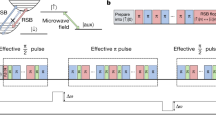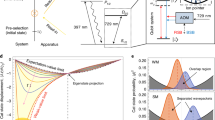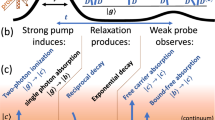Abstract
A measurement necessarily changes the quantum state being measured, a phenomenon known as back-action. Real measurements, however, almost always cause a much stronger back-action than is required by the laws of quantum mechanics. Quantum non-demolition measurements have been devised1,2,3,4,5,6 that keep the additional back-action entirely within observables other than the one being measured. However, this back-action on other observables often imposes its own constraints. In particular, free-space optical detection methods for single atoms and ions (such as the shelving technique7, a sensitive and well-developed method) inevitably require spontaneous scattering, even in the dispersive regime8. This causes irreversible energy exchange (heating), which is a limitation in atom-based quantum information processing, where it obviates straightforward reuse of the qubit. No such energy exchange is required by quantum mechanics9. Here we experimentally demonstrate optical detection of an atomic qubit with significantly less than one spontaneous scattering event. We measure the transmission and reflection of an optical cavity10,11,12,13 containing the atom. In addition to the qubit detection itself, we quantitatively measure how much spontaneous scattering has occurred. This allows us to relate the information gained to the amount of spontaneous emission, and we obtain a detection error below 10 per cent while scattering less than 0.2 photons on average. Furthermore, we perform a quantum Zeno-type experiment to quantify the measurement back-action, and find that every incident photon leads to an almost complete state collapse. Together, these results constitute a full experimental characterization of a quantum measurement in the ‘energy exchange-free’ regime below a single spontaneous emission event. Besides its fundamental interest, this approach could significantly simplify proposed neutral-atom quantum computation schemes14, and may enable sensitive detection of molecules and atoms lacking closed transitions.
This is a preview of subscription content, access via your institution
Access options
Subscribe to this journal
Receive 51 print issues and online access
$199.00 per year
only $3.90 per issue
Buy this article
- Purchase on Springer Link
- Instant access to full article PDF
Prices may be subject to local taxes which are calculated during checkout




Similar content being viewed by others
References
Braginsky, V. B. & Khalili, F. Y. Quantum Measurement (Cambridge Univ. Press, 1992)
Grangier, P., Levenson, J. A. & Poizat, J.-P. Quantum non-demolition measurements in optics. Nature 396, 537–542 (1998)
Nogues, G. et al. Seeing a photon without destroying it. Nature 400, 239–242 (1999)
Maioli, P. et al. Nondestructive Rydberg atom counting with mesoscopic fields in a cavity. Phys. Rev. Lett. 94, 113601 (2005)
Hume, D. B., Rosenband, T. & Wineland, D. J. High-fidelity adaptive qubit detection through repetitive quantum nondemolition measurements. Phys. Rev. Lett. 99, 120502 (2007)
Lupas¸cu, A. et al. Quantum non-demolition measurement of a superconducting two-level system. Nature Phys. 3, 119–125 (2007)
Leibfried, D., Blatt, R., Monroe, C. & Wineland, D. Quantum dynamics of single trapped ions. Rev. Mod. Phys. 75, 281–324 (2003)
Hope, J. J. & Close, J. D. General limit to nondestructive optical detection of atoms. Phys. Rev. A 71, 043822 (2005)
Kwiat, P., Weinfurter, H., Herzog, T., Zeilinger, A. & Kasevich, M. A. Interaction-free measurement. Phys. Rev. Lett. 74, 4763–4766 (1995)
Boozer, A. D., Boca, A., Miller, R., Northup, T. E. & Kimble, H. J. Cooling to the ground state of axial motion for one atom strongly coupled to an optical cavity. Phys. Rev. Lett. 97, 083602 (2006)
Puppe, T. et al. Trapping and observing single atoms in a blue-detuned intracavity dipole trap. Phys. Rev. Lett. 99, 013002 (2007)
Khudaverdyan, M. et al. Quantum jumps and spin dynamics of interacting atoms in a strongly coupled atom-cavity system. Phys. Rev. Lett. 103, 123006 (2009)
Bochmann, J. et al. Lossless state detection of single neutral atoms. Phys. Rev. Lett. 104, 203601 (2010)
Ladd, T. D. et al. Quantum computers. Nature 464, 45–53 (2010)
Helstrom, C. W. Mathematics in Science and Engineering Vol. 123, Quantum Detection and Estimation Theory (Academic, 1976)
Haroche, S. & Raimond, J.-M. Exploring the Quantum (Oxford Univ. Press, 2006)
Gerber, S. et al. Quantum interference from remotely trapped ions. N. J. Phys. 11, 013032 (2009)
Lugiato, L. A. in Progress in Optics Vol. XXI (ed. Wolf, E. ) 69–216 (Elsevier Science, 1984)
Hechenblaikner, G., Gangl, M., Horak, P. & Ritsch, H. Cooling an atom in a weakly driven high-Q cavity. Phys. Rev. A 58, 3030–3042 (1998)
Colombe, Y. et al. Strong atom-field coupling for Bose-Einstein condensates in an optical cavity on a chip. Nature 450, 272–276 (2007)
Hunger, D. et al. A fiber Fabry-Perot cavity with high finesse. N. J. Phys. 12, 065038 (2010)
Gehr, R. et al. Cavity-based single atom preparation and high-fidelity hyperfine state readout. Phys. Rev. Lett. 104, 203602 (2010)
Chernoff, H. A measure of asymptotic efficiency for tests of a hypothesis based on the sum of observations. Ann. Math. Stat. 23, 493–507 (1952)
Itano, W. M. Perspectives on the quantum Zeno paradox. Preprint at 〈http://arXiv.org/abs/quant-ph/0612187v1〉 (2006)
Domokos, P. & Ritsch, H. Mechanical effects of light in optical resonators. J. Opt. Soc. Am. B 20, 1098–1130 (2003)
Jones, K. M., Tiesinga, E., Lett, P. D. & Julienne, P. S. Ultracold photoassociation spectroscopy: long-range molecules and atomic scattering. Rev. Mod. Phys. 78, 483–535 (2006)
Acknowledgements
This work was funded in part by the AQUTE Integrated Project of the EU (grant no. 247687), by the Institut Francilien pour la Recherche sur les Atomes Froids (IFRAF), and by the EURYI grant ‘Integrated Quantum Devices’.
Author information
Authors and Affiliations
Contributions
J.V., R.G. and G.D. performed the experiment. All authors contributed to data analysis and interpretation, as well as to the manuscript.
Corresponding author
Ethics declarations
Competing interests
The authors declare no competing financial interests.
Rights and permissions
About this article
Cite this article
Volz, J., Gehr, R., Dubois, G. et al. Measurement of the internal state of a single atom without energy exchange. Nature 475, 210–213 (2011). https://doi.org/10.1038/nature10225
Received:
Accepted:
Published:
Issue Date:
DOI: https://doi.org/10.1038/nature10225
This article is cited by
-
Quantum networks with neutral atom processing nodes
npj Quantum Information (2023)
-
Achievements and perspectives of optical fiber Fabry–Perot cavities
Applied Physics B (2022)
-
Quantum non-demolition measurement of a many-body Hamiltonian
Nature Communications (2020)
-
To catch and reverse a quantum jump mid-flight
Nature (2019)
-
Quantum image processing?
Quantum Information Processing (2017)
Comments
By submitting a comment you agree to abide by our Terms and Community Guidelines. If you find something abusive or that does not comply with our terms or guidelines please flag it as inappropriate.



